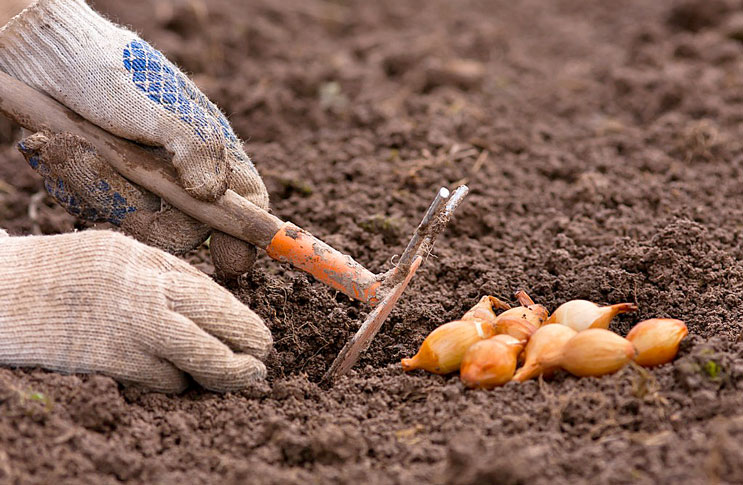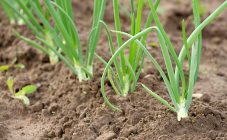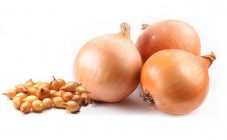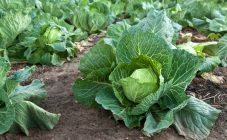Content:
Growing onions in the suburbs does not present any particular difficulties. If several important conditions are met, the harvest will pleasantly please.
Features of planting crops in the Moscow region
The Moscow region is located in central Russia. Most of the crops grown by domestic gardeners are quite adapted to this region and grow well. In extreme cases, especially heat-loving vegetables can always be planted in a greenhouse or provided with additional insulation on cold days.
As for onions, there are no problems with them. The most important thing is to plant a crop in a sufficiently lit, sunny area, otherwise you can only dream of large bulbs. The head in the shade will grow shallow anyway, no matter what the soil is.
The onion bed should not be located in places where water stagnates. The culture does not tolerate acidic and heavy soils. In this regard, experts strongly recommend planting sowing after those plants that required a large amount of organic fertilizers for growing. First of all, we are talking about potatoes, cucumbers, tomatoes and cabbage.
The preparation of the onion beds should begin in the fall. To do this, you will need to carefully dig up the beds and apply a sufficient amount of organic fertilizers. Compost or manure work best. The latter should in no case be fresh - this can provoke a disease of the culture. If the soil has an increased acidity, it will need to be limed. In the spring, before planting, it is the turn of the mineral feeding.
The bow itself will also need to be prepared for planting. To do this, it must be dried in a warm and dark place. For even germination, it is recommended to remove the dry part of the plant neck. It will not be superfluous to treat the sevok with any growth stimulant and soak it for 8 hours in a weak solution of potassium permanganate. Onions are usually planted in late April or early May. The most important thing is to choose a period when the earth has time to warm up, otherwise the culture may go into the arrow.
Having decided when to plant onions in the Moscow region, it remains only to sort out the planting material, bury the bulbs in the soil, sprinkle with earth and water well. The first shoots will begin to appear within a week after planting.
When to plant onions before winter in the Moscow region
To grow a decent bulbous crop, it is not at all necessary to orientate yourself when sowing in April or May. Many gardeners prefer to decide when it is better to plant onion sets in the Moscow region in favor of such a time of year as autumn.
Planting onions before winter has its undoubted advantages. We are talking about the following significant points:
- winter onions require weeding less often (due to the early emergence of shoots);
- planted onions before winter are less susceptible to the attack of onion flies;
- winter road onions have a longer shelf life (subject to high-quality drying according to all the rules).
Sevok, depending on the size, is divided into 4 categories:
- the first - the diameter of the seed varies from 1 to 1.5 cm;
- the second - the diameter of the seed varies from 1.5 to 3 cm;
- category of samples - over 3 cm in diameter;
- oatmeal - less than 1 cm in diameter.
Not everyone knows, but the best onions can be grown from a set of the first category or wild oat. But oat is not suitable for planting before winter. This is due to the fact that such a small onion simply will not be able to overwinter, and when spring comes to the Moscow region, it will have time to dry out.
Any Russian gardener with experience in growing crops such as batun, leek, turnip, etc., understands perfectly how important it is to choose the right planting date. Neither haste nor lateness is acceptable in this case.
It is not so easy to calculate the time when it is best to plant onion sets in the Moscow region. After all, you can only focus on the thermometer and the forecast of weather forecasters. The weather in the autumn in the Moscow region is quite capricious and changeable, and it is always difficult to understand what it will be like in a particular year.
However, cultivation of winter onions will only be successful if it is possible to sow in open ground, at least three weeks before the final freezing of the soil. If the temperature outside the window drops to +5 degrees and does not show an upward trend, it's time to start planting the sevka.
Regardless of which type of onion is planted, the planting depth should vary from 2 to 3 cm. If planted closer to the surface, the plant will die, and if deeper, it will not be able to accumulate enough strength to break through to the surface and will also die.
Sevok of the second category, like onions of the category of samples, can be planted for the winter only with the aim of obtaining a green feather or seed; such varieties are not suitable for obtaining a turnip under any circumstances.
Autumn planting can be carried out in nests of several bulbs or in rows. In all these cases, it is important to observe a depth of 2 cm, the gap between the plants is 10 cm, the distance between the rows is 15-20 cm.
After the seedlings are in the ground, it will not be superfluous to sprinkle the plants with humus or peat. This will provide the freshly planted plant with both nutrition and additional insulation in the winter. It will not be superfluous to organize the plant for mulch. Another layer of natural insulation will be required after the snow covers the garden.
When spring comes, the site will need to be fully opened, removing all the mulch. Small grooves can be plowed over the rows to ensure fast emergence. This should be done with a great deal of care, trying not to harm the future crop.
It will be possible to assess how successful the winter landing turned out to be only in April. If the winter was harsh and snowless, the situation will have to be corrected by planting a sevka belonging to a more commercial category.
What to do if the onion has sprouted
In no case should you rush to planting winter onions. When an onion planted before winter sprouts, it simply freezes and will not sprout in the spring at all. There are no salvage techniques for such a bow.The only way that can be offered in a similar situation (but it is not suitable for everyone) is to transplant the sevok into a warm room. For example, in a house or apartment on a windowsill to obtain green feathers. The answer to the question, the onion planted before the winter sprouted what to do with it, is unambiguous: do not get upset, planting onions to get a turnip will have to be postponed to spring.
Recommendations for gardeners
To ensure the onions are properly cared for and to achieve an excellent harvest, the crop must be properly planted. An increase in the germination rate can be achieved if the winter seeding plant is planted in a place where the snow melts faster and moisture does not stagnate.
Onions are very fond of loose soil with a neutral acidity index. To determine the pH of the soil, gardening stores sell special litmus tests that will allow you to determine in a matter of seconds whether the soil needs liming.
Sometimes the answer to the question why the onion does not grow directly depends on the ventilation of the site. In general, onions are a rather unpretentious crop that grows well in the conditions of the Moscow region and the Moscow region.















